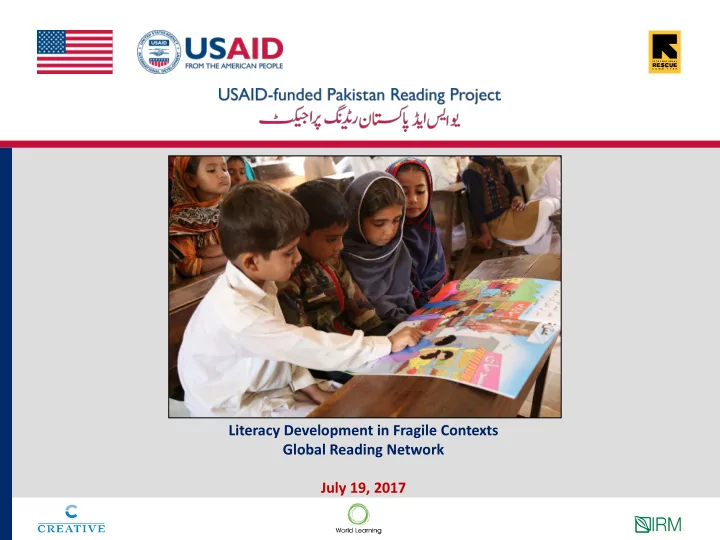

Literacy Development in Fragile Contexts Global Reading Network July 19, 2017
Agenda ▪ Mitigating effects of adversity ▪ Pakistani context ▪ Overview of Pakistan Reading Project ▪ PRP program implementation in depth look: Materials development ▪ Challenges and lessons learned ▪ PRP successes ▪ Further Research
Relationships with Peers Feelings of Sense of Self Belonging Confidence Sense of Personal Control Attachments Learning to read in a Sense of Intellectual Safety Stimulation healing classroom
Pakistan: Fragility Footprint Geo-political conditions Gender Equity Literacy Landscape
Pakistan: Student Reading Achievement Data The national-level data of the Annual Status of Education Report (ASER) – 2013 shows that, on average, 40 percent of third grade public school children in Pakistan cannot read a sentence in Urdu. Pakistan Reading Project 2015 EGRA baseline data results demonstrate high percentages of zero scores in ORF and low percentage of correct letter sound knowledge:
Key Targets 1.3 million grade 1 and 2 students 23,800 teachers 3,161 scholarships Award Period June 28, 2013 to June 27, 2018 Total Estimated USAID Amount $165 M Provincial Offices=7 District Offices= 38 Total PRP Staff= 665
Pakistan Reading Project Overview ▪ Improved Classroom Learning Environment for Reading ▪ Improved Policies and Systems for Reading ▪ Community Based Support for Reading ▪ Gender ▪ Monitoring, Evaluation & Learning
Overall Program Achievements 30 15,535 446,023 Grants Teachers Students 3,988,989 Teaching Learning Materials 3,161 114,895 28 Scholarships School Supports Visits Policies
PRP: Contributing to improved reading skills of students Urdu Percentage of Grade 2 Students in Cohort 1 Students with Zero Scores from Baseline to Endline 45% 42.2% 40% 35% 30.5% 30% 26.5% 23.4% 25% 20.8% 17.1% 20% 16.2% 16.0% 15.6% 14.8% 15% 10% 2.8% 5% 0.1% 0% Orientation to Print Phonemic Awareness Letter Sound Fluency Familiar Word Oral Reading Fluency Reading Comprehension Baseline Endline
Teaching Learning Materials (TLM) Grade 1 and 2 TLM in Urdu, Sindhi, Pashto Teacher Package Daily lesson plans, flash cards, syllable charts, big books, leveled readers Student Package Student workbook Classroom based formative assessments
Challenges and Lessons Learned Material Classroom Context development process Capacity building Security Gender Equity Governance systems
Successes Quality reading Community Valorizing mother materials and Reading Policies Engagement tongue training Promoting Fostering safe and Print-rich equitable healing classroom environment representation practices
Further Research ▪ Building body of evidence for fragile states ▪ Evaluating programs at scale ▪ Considering program impact on both academic skills and social emotional well being
Questions?
Thank you!
Resources International Network for Education in Emergencies: Conflict Sensitive Education Pack on the INEE website at ineesite.org/education-fragility/conflict-sensitive-educatio. International Rescue Committee. (2013). Learning to Read in Healing Classrooms . New York City: IRC. International Rescue Committee. (2016). Safe and Healing Learning Spaces . New York City: IRC. National Education Management Information System Academy of Educational Planning and Management Ministry of Federal Education and Professional Training, Government of Pakistan. (2017) Pakistan Education Statistics 2015-16. Islamabad. NEMIS-AEPAM USAID. (2012). Pakistan Gender Analysis and Gender Assessment of Stabilization Programming . Washington, D.C.: USAID. USAID. (2014). Literacy Education in Crisis Contexts. Washington, D.C.: USAID. USAID. (2014 ). Identifying Reading Barriers in Pakistan. Washington, D.C: USAID. Pakistan Education Statistics USAID. (2015). Rapid Education and Risk Analysis . Washington, D.C: USAID. USAID. (2017) Landscape Report on Early Grade Literacy. Washington, D.C.: USAID.
Recommend
More recommend